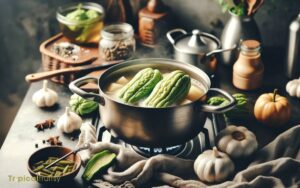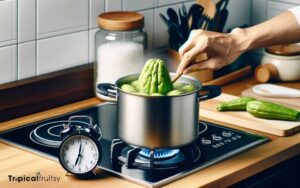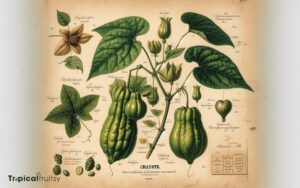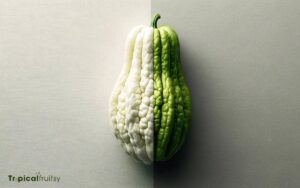How to Make Chayote Tea?
Brewing chayote tea is a simple process that results in a drink with potential health benefits. To make chayote tea, choose a fresh chayote squash, wash it, slice it, and then simmer the pieces in water.
For added flavor, consider including ingredients like ginger, lemon, or honey. This tea can be a delightful addition to your wellness routine.
Chayote tea is made by:
This tea is known for its mild taste and versatility when it comes to flavor enhancements.
Enjoy the mild and refreshing taste of homemade chayote tea, a delightful herbal infusion.
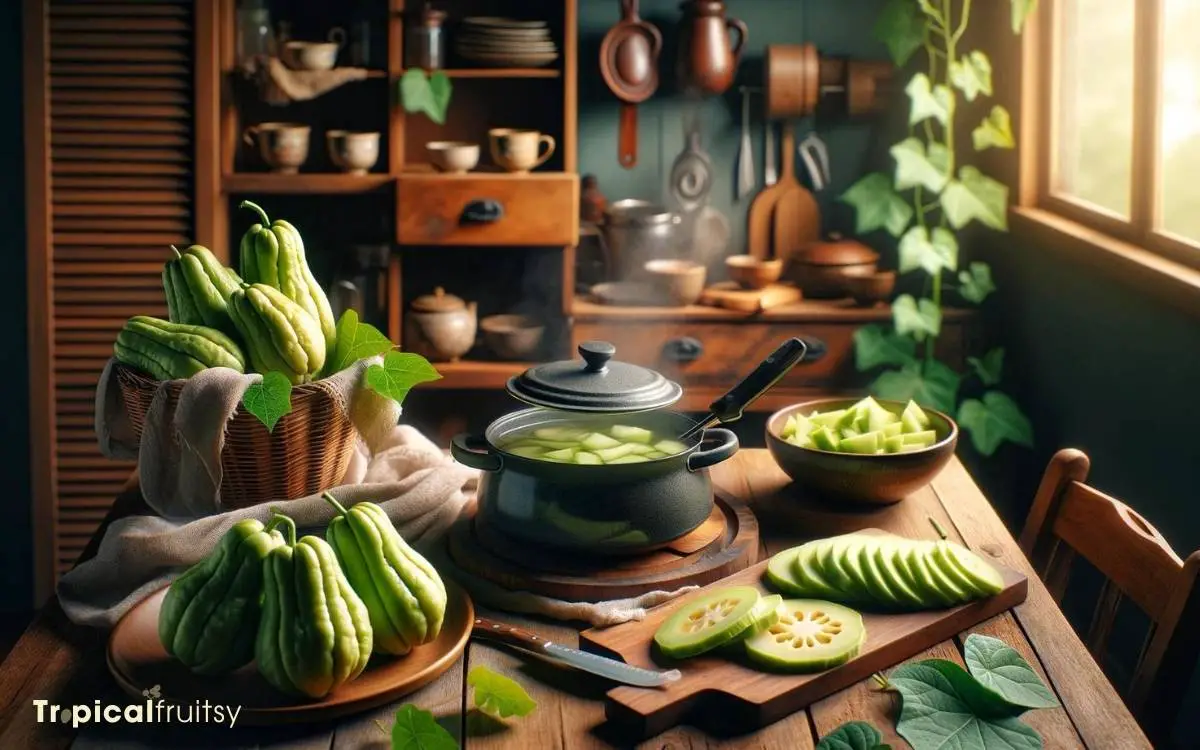
Key Takeaway
Step 1: Selecting the Perfect Chayote
Choosing a fresh chayote with firm skin and a light green color is crucial for crafting a flavorful chayote tea.
The chayote, also known as Sechium edule, should not exhibit any brown spots or signs of wilting, as these are indicators of age or improper storage, which can adversely affect both taste and nutritional value.
A fresh chayote is typically firm to the touch, yet slightly yielding, indicating optimal ripeness.
Furthermore, the size of the chayote can influence its flavor profile; smaller ones tend to be more tender and less fibrous, thus preferable for a delicate tea infusion.
After selecting the ideal chayote, the next step involves thoroughly washing and preparing the vegetable to ensure the purity and quality of your tea.
Step 2: Washing and Preparing Chayote
Once you have selected a prime chayote, the next essential step is to meticulously wash and prepare the vegetable to ensure it is clean and ready for use in making your tea.
Begin by rinsing the chayote under cool running water, scrubbing the surface with a vegetable brush to remove any dirt or potential residues.
Given that produce can harbor bacteria and pesticides, this step is crucial for safety and purity of the final tea.
Pat the chayote dry with a clean towel to remove excess moisture. Ensure your hands and all surfaces are also clean to prevent any cross-contamination.
With the chayote now properly cleaned, the preparation for crafting your tea can proceed. Next, we will explore the process of slicing the chayote to optimize the extraction of its beneficial properties.
Step 3: Slicing the Chayote
After thoroughly cleaning the chayote, slice it into thin pieces to facilitate the release of its flavors and nutrients during the brewing process.
Thin slices increase the surface area, allowing more efficient extraction of the beneficial compounds contained within the chayote, such as vitamins, minerals, and antioxidants.
Here is a step-by-step guide to slicing the chayote:
- Stabilize the Chayote: Place the chayote on a cutting board and hold it firmly to prevent slipping.
- Cut Evenly: Using a sharp knife, make consistent, thin slices about 1/8 to 1/4 inch thick to ensure uniform brewing.
- Handle Carefully: Exercise caution with the knife to maintain safety and to preserve the integrity of each slice for optimal tea infusion.
The precision in slicing not only contributes to a more flavorful tea but also ensures a pleasant aesthetic and texture when served.
Step 4: Choosing Your Additional Ingredients
The selection of complementary ingredients, such as fresh ginger, honey, or lemon, can enhance the flavor profile and health benefits of your chayote tea.
Fresh ginger, known for its anti-inflammatory properties, can add a warming and spicy undertone, which may soothe digestion and alleviate nausea.
Honey, a natural sweetener, not only balances the flavor with its subtle sweetness but also brings antibacterial benefits, making it a healthful addition to chayote tea.
Meanwhile, lemon, rich in vitamin C, can provide a refreshing citrus note and boost the immune system.
When choosing these ingredients, consider their organic and raw forms to maximize the preservation of their natural nutrients and enzymes, thereby ensuring a more potent and beneficial cup of chayote tea.
Step 5: Boiling Water for Tea
Begin by bringing a pot of fresh water to a rolling boil, ensuring it reaches the optimal temperature for steeping chayote tea. The quality of water used can significantly affect the flavor and overall enjoyment of the tea.
Here are essential steps to consider:
- Use Filtered Water: Impurities in tap water can alter the taste. Filtered or spring water is recommended for a cleaner taste.
- Proper Temperature: Aim for a temperature just below boiling, around 190-200°F (87-93°C), to avoid scorching the chayote slices.
- Avoid Over-Boiling: Boiling water for too long can deplete oxygen levels, resulting in a flat-tasting tea. Bring the water to a swift boil and use it promptly.
With the water now ready, we can move on to the delicate process of steeping chayote slices.
Step 6: Steeping Chayote Slices
Steeping chayote slices is a critical step in crafting a flavorful tea, with the optimal duration being typically between 5 to 10 minutes.
The temperature of the water should be just below boiling point to ensure that the delicate flavors are extracted without destroying heat-sensitive compounds.
Additionally, the thickness of the chayote slices can influence the steeping process, with thinner slices requiring shorter steeping times to release their full flavor profile.
Optimal Steeping Time
For an ideal infusion, steep chayote slices in boiling water for approximately 5-7 minutes. This duration is crucial to ensure the extraction of the chayote’s subtle flavors and beneficial compounds without oversteeping, which can lead to a bitter taste.
To enhance the tea-drinking experience, consider the following points:
- Water Temperature: Use boiling water to ensure the cellular structure of the chayote breaks down, releasing its flavor and nutrients effectively.
- Slice Thickness: Thinner slices of chayote will steep more quickly, allowing for a more robust flavor extraction within the optimal time frame.
- Covering the Vessel: Cover the steeping vessel to retain heat and prevent the escape of volatile compounds that contribute to the tea’s aroma and taste profile.
Adhering to these guidelines will result in a chayote tea that is both flavorful and healthful.
Water Temperature Importance
The water temperature plays a pivotal role in the steeping process of chayote slices, as it directly affects the efficiency of flavor and nutrient extraction.
For chayote tea, a delicate balance is required; water that’s too hot may compromise the vegetable’s subtle flavors and destroy some of its beneficial compounds, while water that’s not hot enough might fail to release the full spectrum of flavors and nutrients.
Typically, a temperature just below boiling, around 90 to 95 degrees Celsius, is recommended to ensure optimal extraction.
This range is hot enough to facilitate the release of chayote’s essential nutrients and volatile compounds, which contribute to both the tea’s health benefits and its unique taste profile, without causing detrimental effects on the sensitive constituents of the chayote.
Slice Thickness Variation
While preparing chayote for tea, the thickness of the slices can significantly influence the steeping time and the intensity of the flavor extracted.
The surface area of the chayote exposed to the water will determine how much of its essence is imparted into the brew.
Here are key considerations:
- Thin Slices: Offer a larger surface area, which allows for quicker infusion and a more robust flavor.
- Thick Slices: Require a longer steeping time to extract flavor, potentially leading to a milder taste.
- Consistency: Uniform slice thickness ensures even steeping, providing a balanced flavor profile throughout the tea.
For optimal results, it’s recommended to experiment with slice thickness to find the perfect balance for your palate, while also considering the steeping time and water temperature.
Step 7: Optional Sweeteners and Flavors
How might one enhance the delicate taste of chayote tea with natural sweeteners and aromatic flavors?
The subtle, slightly sweet profile of chayote tea provides a versatile canvas for various enhancements.
Sweeteners like honey or agave nectar can be introduced to accentuate the tea’s innate sweetness without overpowering its unique flavor.
Evidence suggests that natural sweeteners may also offer health benefits such as antioxidants found in raw honey.
For those desiring complexity, a cinnamon stick or a few slices of fresh ginger infused with the tea can add a warming note and may aid digestion.
Additionally, a sprig of mint or a dash of vanilla extract could provide a refreshing undertone, turning the simple chayote tea into a more sophisticated brew.
Step 8: Serving Chayote Tea
Upon completion of brewing, serving chayote tea at an optimal temperature enhances the beverage’s delicate flavor profile.
While the tea can be enjoyed in its pure form, the addition of sweeteners such as honey or agave syrup may cater to individual taste preferences.
To elevate the tea-drinking experience, consider presenting the tea in clear glassware that showcases its light green hue, possibly garnished with a slice of chayote or a sprig of mint for visual appeal.
Optimal Serving Temperature
Regarding the optimal serving temperature, chayote tea should be enjoyed at a warmth that allows the flavors to unfold without scalding the palate, typically between 160°F to 185°F (71°C to 85°C).
The temperature is crucial as it influences the extraction of the chayote’s subtle flavors and beneficial compounds.
Here are key considerations:
- Flavor Maximization: At this range, the natural sweetness and delicate nuances of chayote are most apparent.
- Digestive Comfort: Warmer liquids can aid in digestion, making it a soothing choice post-meal.
- Chemical Stability: Excessive heat may degrade some of the healthful phytonutrients present in chayote.
As we consider the full sensory experience of chayote tea, let us also explore the potential enhancement of flavor with accompanying sweeteners.
Accompanying Sweeteners
Considering the delicate flavor profile of chayote tea, introducing a sweetener can enhance its taste while complementing its natural subtleties.
For those seeking to sweeten chayote tea, evidence suggests that natural sweeteners may be preferable to refined sugars.
Honey, for instance, is a popular choice due to its rich antioxidants and soothing properties, which may synergize well with the health benefits of chayote tea.
Another option is agave nectar, which possesses a low glycemic index, making it an attractive sweetener for those monitoring their blood sugar levels.
Stevia, a natural, calorie-free sweetener, can also be suitable, especially for individuals managing caloric intake.
The key is to add these sweeteners judiciously, ensuring they highlight rather than overpower the tea’s subtle flavor nuances.
Presentation Ideas
After selecting a natural sweetener to enhance the flavor of chayote tea, thoughtful presentation can further elevate the tea-drinking experience for your guests or personal enjoyment.
Here are three ways to beautifully serve chayote tea:
- Use Transparent Glassware: Opt for clear glass cups or teapots to showcase the tea’s natural color and clarity. This visual appeal can enhance the sensory enjoyment of the tea.
- Garnish with Fresh Ingredients: A sprig of mint or a slice of lemon can add a refreshing touch. It’s not only visually appealing but can also impart a subtle flavor twist to the tea.
- Serve on a Bamboo Tray: Present the tea on a bamboo or wooden tray for a natural, earthy aesthetic that complements the organic nature of chayote tea.
Step 9: Storing Leftover Tea
How should one properly store any remaining chayote tea to maintain its freshness and flavor?
To ensure that leftover chayote tea retains its quality, it should be stored in an airtight container. This minimizes exposure to air, which can degrade the tea’s flavor through oxidation.
Once in a suitable container, the tea should be refrigerated to slow down the growth of bacteria and mold. Drinking refrigerated chayote tea within 24 hours is ideal; however, it can be kept for up to 48 hours without significant loss of taste.
For longer storage, freezing the tea in ice cube trays can preserve its freshness for several weeks. When thawed, these cubes can be enjoyed cold or reheated, offering a convenient way to savor the tea at a later date.
Conclusion
The infusion of chayote in hot water yields a delicate beverage, subtly flavored and potentially beneficial for health.
Selecting a fresh chayote, meticulous preparation, and proper steeping techniques are paramount for crafting an optimal tea experience.
Coinciding with the rise of interest in traditional and herbal teas, chayote tea offers a unique addition to the repertoire of natural infusions. Proper storage ensures the longevity of its delicate flavor profile for subsequent enjoyment.

